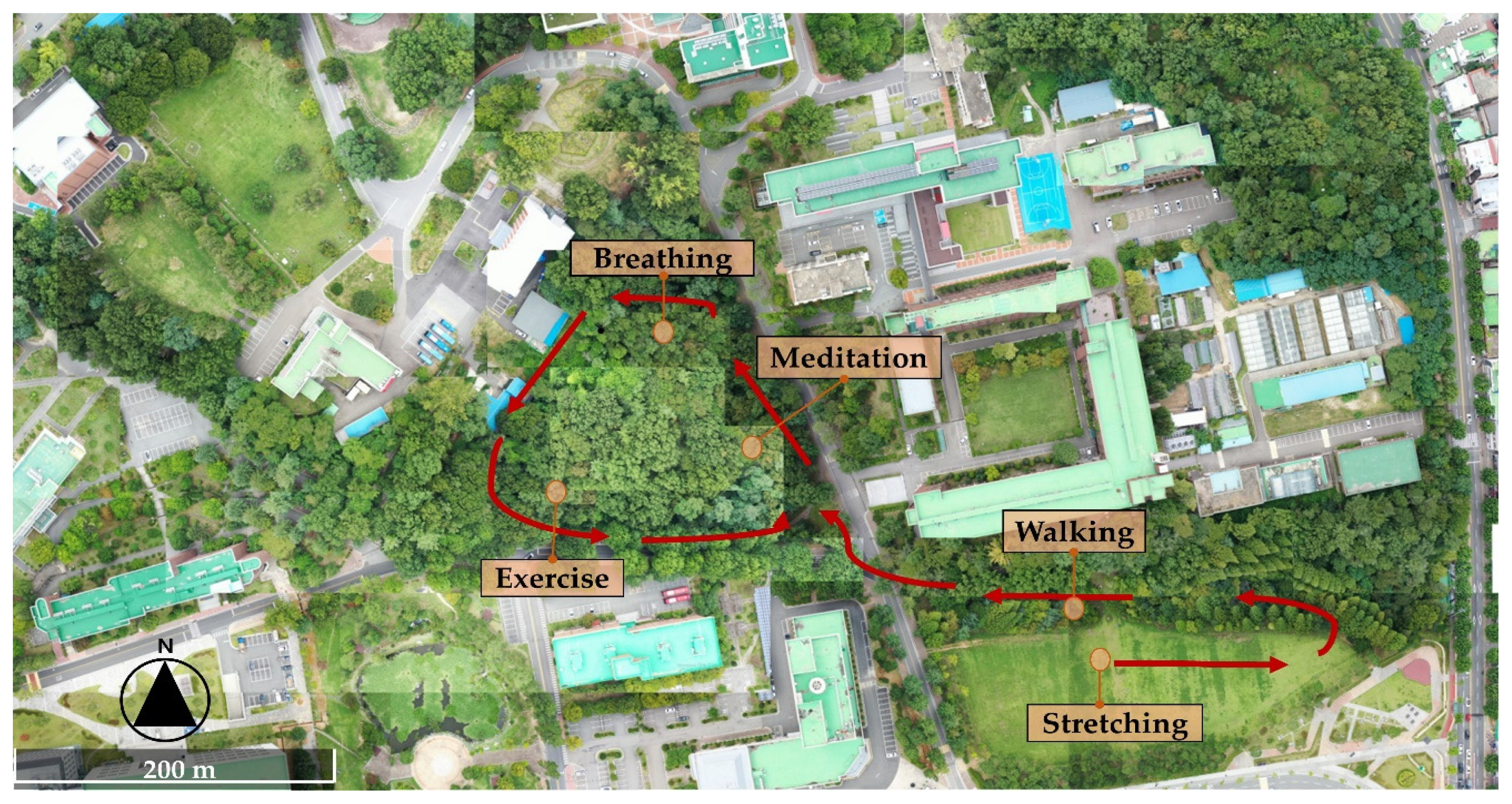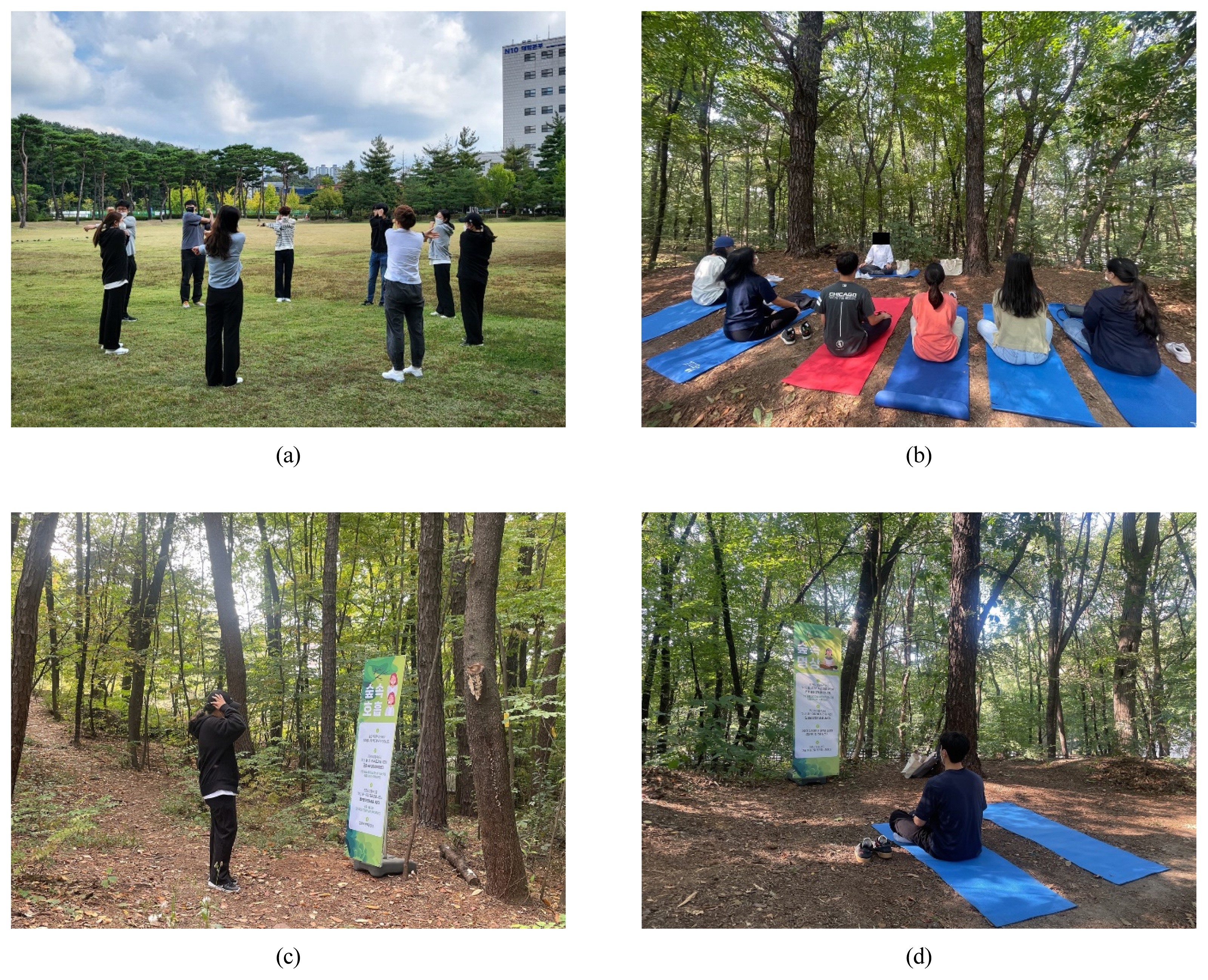American University Health Association. 2017. National University Health Assessment II: Undergraduate Executive Summary Spring 2017 American University Health Association. Hanover, MD, USA:
Barton, J., J. Pretty. 2010. What is the best dose of nature and green exercise for improving mental health? A multi-study analysis. Environmental Science and Technology. 44(10):3947-3955.
https://doi.org/10.1021/es903183r


Boden, J.M., D.M. Fergusson, L.J. Horwood. 2008. Does adolescent self-esteem predict later life outcomes? A test of the causal role of self-esteem. Development and Psychopathology. 20(1):319-39.
https://doi.org/10.1017/S0954579408000151


Cervinka, R., K. RûÑderer, E. Hefler. 2011. Are nature lovers happy? On various indicators of well-being and connectedness with nature. Journal of Health Psychology. 17(3):379-388.
https://doi.org/10.1177/1359105311416873


Harris, M.A., U. Orth. 2020. The link between self-esteem and social relationships: A meta-analysis of longitudinal studies. Journal of Personality and Social Psychology. 119(6):1459-1477.
https://doi.org/10.1037/pspp0000265


Hurst, C.S., L.E. Baranik, F. Daniel. 2013. University student stressors: A review of the qualitative research. Stress and Health. 29:275-285.
https://doi.org/10.1002/smi.2465


Kasap, E.Z., F. AázáÝtemiz, G. ûnal. 2021. Cognitive, mental and social benefits of interacting with nature: A systematic review. Journal of Happiness and Health. 1(1):16-27.
Keenan, R., R. Lumber, M. Richardson, D. Sheffield. 2021. Three good things in nature: a nature-based positive psychological intervention to improve mood and well-being for depression and anxiety. Journal of Public Mental Health. 20(4):243-250.
https://doi.org/10.1108/JPMH-02-2021-0029

Kim, D.H., S.C. Park, M.K. Cho, J.N. Kwon, J.W. Hong, I. Lee. 2014. The effects of moxibustion at CV12 on cerebral blood flow and peripheral blood flow. The Journal of Internal Korean Medicine. 35(1):24-36.
Kim, J.G. 2021. The effect of Self-guided forest therapy program. Doctoral dissertation. Chungbuk National University, Cheongju, Korea.
Kim, I.O., W.S. Shin, J.Y. Jeon. 2020. The effects of a forest therapy program on the self-esteem and resilience of juveniles under protective detention. Journal of People, Plants, and Environment. 23(4):485-494.


Korcz, N., E. Janeczko, E. Bielinis, D. Urban, J. Koba, P. Szabat, M. Maéeck. 2021. Influence of informal education in the forest stand redevelopment area on the psychological restoration of working adults. Forests. 12(8):993.
https://doi.org/10.3390/f12080993

Lee, H.H., E.J. Kim, M.K. Lee. 2003. A validation study of Korea positive and negative affect schedule: the PANAS scales. Korean Journal of Clinical Psychology. 22(4):935-946.
Lee, J.H., J. Hong, Y. Tae. 2017. Analysis of change of emotion and self-esteem of at-risk children through forest activities. The Journal of Korean institute of Forest Recreation. 21(3):1-9.
https://doi.org/10.34272/forest.2017.21.3.001

Lee, J.H., T.H. Kim, S.Y. Kang, D.G. Kum, S.Y. Lee, K.S. Do, C.S. Kim, J.H. Bae, J.H. Park, J.E. Kim. 2021. The effects of active movement myofascial decompression therapy and static myofascial decompression therapy on range of motion, muscle strength, functional movement in young adults. Journal of The Korean Society of Integrative Medicine. 9(3):165-173.
https://doi.org/10.15268/ksim.2021.9.3.165

Lim, Y.S., D.J. Kim, P.S. Yeoun. 2014. Changes in depression degree and self-esteem of senior citizens in a nursing home according to forest therapy program. The Journal of Korean institute of Forest Recreation. 18:1-11.
https://doi.org/10.34272/forest.2014.18.1.001

Lipson, S.K., S. Zhou, S. Abelson, J. Heinze, M. Jirsa, J. Morigney, A. Patterson, M. Singh, D. Eisenberg. 2022. Trends in university student mental health and help-seeking by race/ethnicity: Findings from the national healthy minds study, 2013ã2021. Journal of Affective Disorders. 306:138-147.
https://doi.org/10.1016/j.jad.2022.03.038



Mayer, F.S., C.M. Frantz. 2004. The connectedness to nature scale: A measure of individualsã feeling in community with nature. Journal of Environmental Psychology. 24(4):503-515.
https://doi.org/10.1016/j.jenvp.2004.10.001

Mayer, F.S., C.M. Frantz, E. Bruehlman-Senecal, K. Dolliver. 2009. Why is nature beneficial? The role of connectedness to nature. Environment and Behavoir. 41(5):607-643.
https://doi.org/10.1177/0013916508319745

Meneguzzo, F., L. Albanese, M. Antonelli, R. Baraldi, F.R. Becheri, F. Centritto, D. Donelli, F. Finelli, F. Firenzuoli, G. Margheritin, V. Maggini, S. Nardini, M. Regina, F. Zabini, L. Neri. 2021. Short-term effects of forest therapy on mood states: a pilot study. International Journal of Environmental Research and Public Health. 18(18):9509.
https://doi.org/10.3390/ijerph18189509



Ochiai, H., H. Ikei, C. Song, M. Kobayashi, T. Miura, T. Kagawa, Q. Li, S. Kumeda, M. Imai, Y. Miyazaki. 2015. Physiological and psychological effects of a forest therapy program on middle-aged females. International Journal of Environmental Research and Public Health. 12(12):15222-15232.
https://doi.org/10.3390/ijerph121214984



Orth, U., E.C. Luciano. 2015. Self-esteem, narcissism, and stressful life events: Testing for selection and socialization. Journal of Personality and Social Psychology. 109(4):707-721.
https://doi.org/10.1037/pspp0000049


Piva, G., L. Caruso, A.C. Gû°mez, M. Calzolari, E.P. Visintin, P. Davoli, F. Manfredin, A. Storari, P. Spinozzi, N. Lamberti. 2022. Effects of forest walking on physical and mental health in elderly populations: a systematic review. Reviews on Environmental Health.
https://doi.org/10.1515/reveh-2022-0093

Rajoo, K.S., D.S. Karam, M.Z. Abdullah. 2020. The physiological and psychosocial effects of forest therapy: A systematic review. Urban Forestry and Urban Greening. 54:126744.
https://doi.org/10.1016/j.ufug.2020.126744

Rosenberg, M. 1965. The measurement of self-esteem, society and the adolescent self-image. Princeton. 16-36.
Rosenberg, M., C. Schooler, C. Schoenbach, F. Rosenberg. 1995. Global self-esteem and specific self-esteem: Different concepts, different outcomes. American Sociological Review. 60(1):141-156.
https://doi.org/10.2307/2096350

Song, C., H. Ikei, T. Kagawa, Y. Miyazaki. 2019b. Physiological and psychological effects of viewing forests on young women. Forests. 10(8):635.
https://doi.org/10.3390/f10080635

Stinson, D.A., C. Logel, M.P. Zanna, J.G. Holmes, J.J. Cameron, J.V. Wood, S.J. Spencer. 2008. The cost of lower self-esteem: testing a self-and social-bonds model of health. Journal of Personality and Social Psychology. 94(3):412-428.
https://doi.org/10.1037/0022-3514.94.3.412


Takayama, N., K. Korpela, J. Lee, T. Morikawa, Y. Tsunetsugu, B.J. Park, L.Q. Li, L. TyrvûÊinen, Y. Miyazaki, T. Kagawa. 2014. Emotional, restorative and vitalizing effects of forest and urban environments at four sites in Japan. International Journal of Environmental Research and Public Health. 11(7):7207-7230.
https://doi.org/10.3390/ijerph110707207



Trzesniewski, K.H., M.B. Donnellan, R.W. Robins. 2003. Stability of self-esteem across the life span. Journal of Personality and Social Psychology. (1):205-20.


Tsunetsugu, Y., J. Lee, B.J. Park, L. TyrvûÊinen, T. Kagawa, Y. Miyazak. 2013. Physiological and psychological effects of viewing urban forest landscapes assessed by multiple measurements. Landscape and Urban Planning. 113:90-93.
https://doi.org/10.1016/j.landurbplan.2013.01.014

Watson, D., L.A. Clark, A. Tellegen. 1988. Development and validation of brief measures of positive and negative affect: the PANAS scales. Journal of Personality and Social Psychology. 54(6):1063PMID:
10.1037//0022-3514.54.6.1063


Yeon, P.S., J.Y. Jeon, M.S. Jung, G.M. Min, G.Y. Kim, K.M. Han, M.J. Shin, S.H. Jo, J.G. Kim, W.S. Shin. 2021. Effect of forest therapy on depression and anxiety: A systematic review and meta-analysis. International Journal of Environmental Research and Public Health. 18(23):12685.
https://doi.org/10.3390/ijerph182312685



Yeon, P.S., I.O. Kim, S.N. Kang, N.E. Lee, G.Y. Kim, G.M. Min, C.Y. Chung, J.S. Lee, J.G. Kim, W.S. Shin. 2022. Effects of urban forest therapy program on depression patients. International Journal of Environmental Research and Public Health. 20(1):507.
https://doi.org/10.3390/ijerph20010507



Yu, Y. M., Y.J. Lee, J.Y. Kim, S.B. Yoon, C.S. Shin. 2016. Effects of forest therapy camp on quality of life and stress in postmenopausal women. Forest Science and Technology. 12(3):125-129.
https://doi.org/10.1080/21580103.2015.1108248












